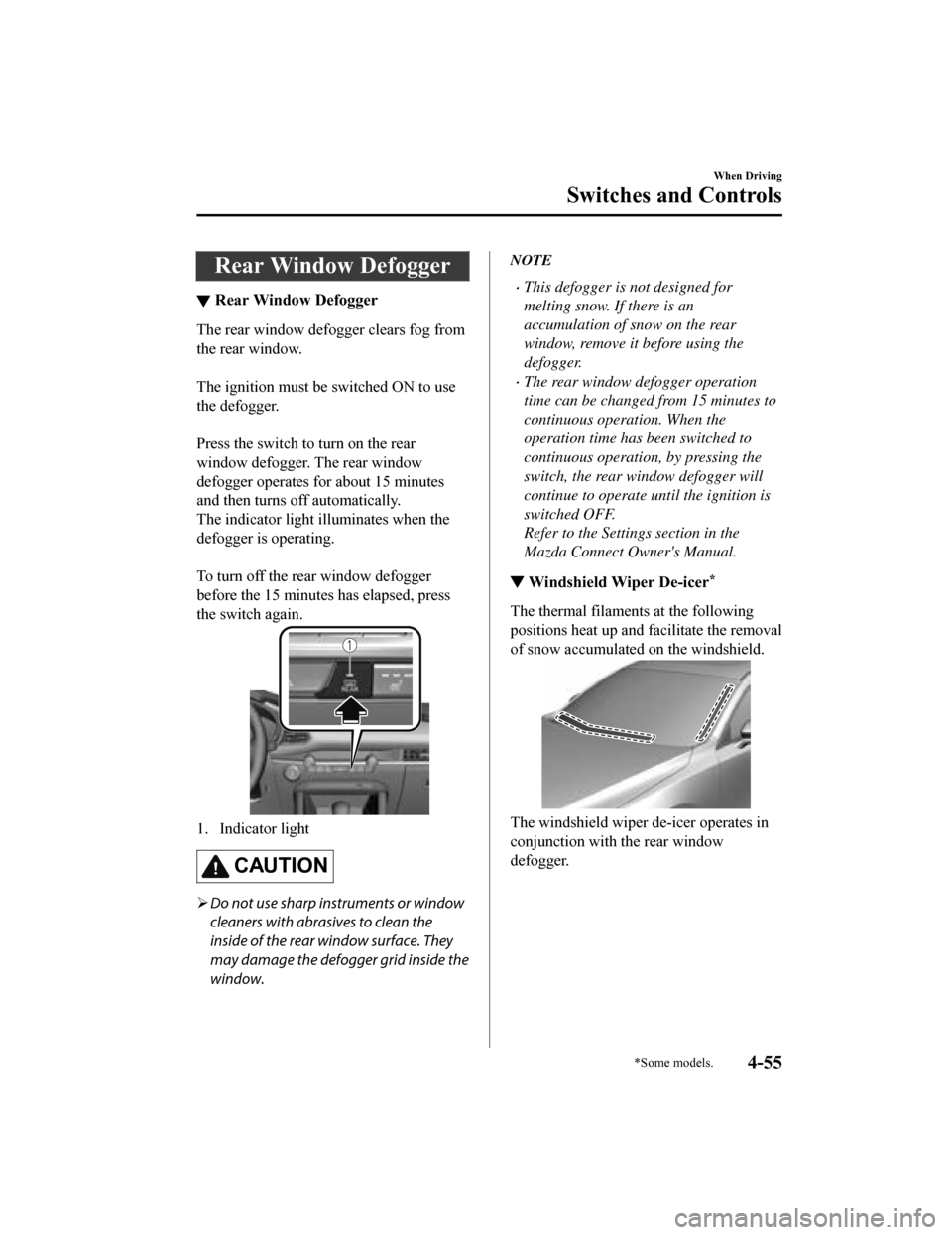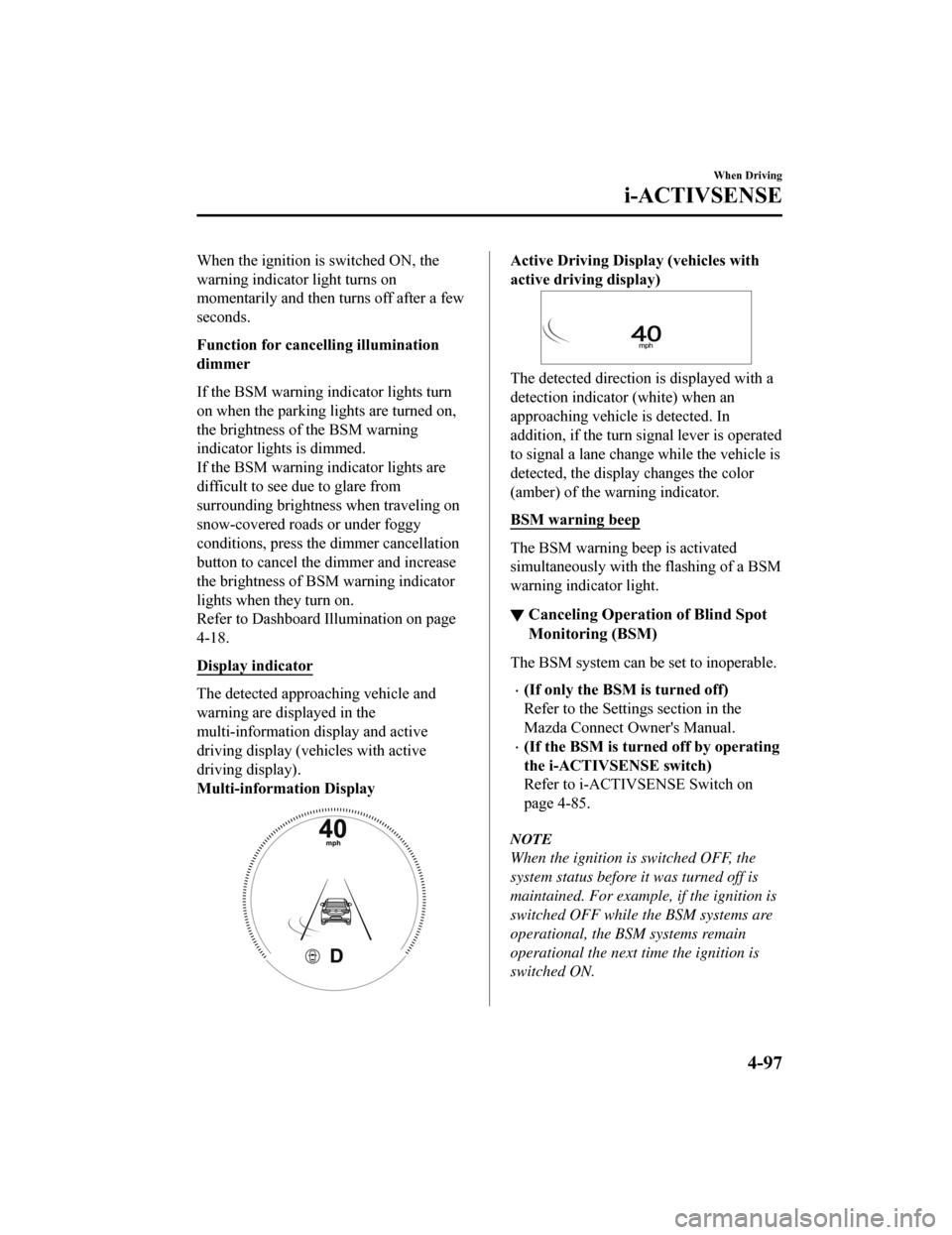fog light MAZDA MODEL 3 HATCHBACK 2019 Owners Manual (in English)
[x] Cancel search | Manufacturer: MAZDA, Model Year: 2019, Model line: MODEL 3 HATCHBACK, Model: MAZDA MODEL 3 HATCHBACK 2019Pages: 592, PDF Size: 12.19 MB
Page 141 of 592

4When Driving
Information concerning safe driving and stopping.
Start/Stop Engine.............................. 4-4 Ignition Switch........ ..................... 4-4
Starting the Engine....................... 4-5
Turning the Engine Off...............4-10
Cylinder Deactivation
*............... 4-11
Instrument Cluster and Display ............
........................................................... 4-12 Instrument Cluster and
Display........................................4-12
Instrument Cluster...................... 4-12
Active Driving Display
*............. 4-28
Manual Transmission
Operation......................................... 4-30 Manual Transmission Shift
Pattern......................................... 4-30
Automatic Transmission................. 4-32 Automatic Transmission
Controls...................................... 4-32
Shift-Lock System...................... 4-33
Transmission Ranges.................. 4-34
Manual Shift Mode..................... 4-35
Direct Mode
*.............................. 4-41
Driving Tips................................4-42
Switches and Controls..................... 4-43 Lighting Control......................... 4-43
Turn and Lane-Change
Signals........................................ 4-49
Windshield Wipers and
Washer........................................ 4-50
Rear Window Wiper and Washer
*.....
.................................................... 4-54
Rear Window Defogg er.............. 4-55
Horn............................................ 4-56
Hazard Warning Flasher............. 4-57
HomeLink Wireless Control
System
*.......................................4-57
Brake................................................ 4-62 Brake System.............................. 4-62
AUTOHOLD.............................. 4-68
Hill Launch Assist (HLA).......... 4-72
ABS/TCS/DSC................................. 4-74 Antilock Brake System
(ABS)..........................................4-74
Traction Control System
(TCS).......................................... 4-75
Dynamic Stability Control
(DSC)..........................................4-76
Drive Selection................................. 4-78 Drive Selection
*..........................4-78
i-ACTIV AWD................................. 4-80 i-ACTIV AWD Operation
*.........4-80
*Some models.4-1
Mazda3_8HE9-EA-18K_Edition1 2018-10-17 19:05:10
Page 195 of 592

Rear Window Defogger
▼Rear Window Defogger
The rear window defogger clears fog from
the rear window.
The ignition must be switched ON to use
the defogger.
Press the switch to turn on the rear
window defogger. The rear window
defogger operates for about 15 minutes
and then turns off automatically.
The indicator light illuminates when the
defogger is operating.
To turn off the rear window defogger
before the 15 minutes has elapsed, press
the switch again.
1. Indicator light
CAUTION
Do not use sharp instruments or window
cleaners with abrasives to clean the
inside of the rear window surface. They
may damage the defogger grid inside the
window.
NOTE
This defogger is not designed for
melting snow. If there is an
accumulation of snow on the rear
window, remove it before using the
defogger.
The rear window defogger operation
time can be changed from 15 minutes to
continuous operation. When the
operation time has been switched to
continuous operation, by pressing the
switch, the rear window defogger will
continue to operate until the ignition is
switched OFF.
Refer to the Settings section in the
Mazda Connect Owner's Manual.
▼ Windshield Wiper De-icer*
The thermal filaments
at the following
positions heat up and facilitate the removal
of snow accumulated on the windshield.
The windshield wiper de-icer operates in
conjunction with the rear window
defogger.
When Driving
Switches and Controls
*Some models.4-55
Mazda3_8HE9-EA-18K_Edition1 2018-10-17 19:05:10
Page 196 of 592

To turn on the windshield wiper de-icer,
switch the ignition ON and press the rear
window defogger switch (page 4-55).
1. Indicator light
▼ Mirror Defogger*
The mirror defoggers defrost the outside
mirrors.
The mirror defoggers operate in
conjunction with the rear window
defogger.
To turn on the mirror defoggers, switch the
ignition ON and press the rear window
defogger switch (page 4-55).
1. Indicator light
Horn
▼ Horn
To sound the horn, press the mark on
the steering wheel.
When Driving
Switches and Controls
4-56*Some models.
Mazda3_8HE9-EA-18K_Edition1 2018-10-17 19:05:10
Page 228 of 592

High Beam ControlSystem (HBC)
*
▼ High Beam Control System (HBC)
The HBC determines the conditions in
front of the vehicle using the Forward
Sensing Camera (FSC) while driving in
darkness to automatically switch the
headlights between high and low beams.
Refer to Forward Sen
sing Camera (FSC)
on page 4-198.
While driving the vehicle at a speed of
about 30 km/h (19 mph) or more, the
headlights are switched to high beams
when there are no vehicles ahead or
approaching in the opposite direction.
The system switches the headlights to low
beams when one of th e following occurs:
The system detects a vehicle or the
headlights/lights of a vehicle
approaching in the opposite direction.
The vehicle is driven on roads lined with
streetlamps or on roads in well-lit cities
and towns.
The vehicle is driven at less than about
20 km/h (12 mph).
The headlight high-beam indicator light
turns on while the high beams are on.
1. Forward Sensing Camera (FSC)*1
*1 The recognition distance of the Forward Sensing
Camera (FSC) varies according to the
surrounding conditions.
The warning light turns on when the
system has a malfunction.
Refer to High Be am Control System
(HBC) Warning Indication/Warning Light
(Amber) on page 7-33.
CAUTION
Do not adjust the vehicle height, modify
the headlight units, or remove the
camera, otherwise the system will not
operate normally.
Do not rely excessively on the HBC and
drive the vehicle while paying sufficient
attention to safety. Switch the headlights
between the high beams and low beams
manually if necessary.
NOTE
The timing in which the system switches
the headlights changes under the
following conditions. If the system does
not switch the headlights appropriately,
manually switch between high and low
beams according to the visibility as well as
road and traffic conditions.
When there are sources of light in the
area such as street lamps, illuminated
signboards, and traffic signals.
When there are reflective objects in the
surrounding area such as reflective
plates and signs.
When visibility is reduced under rain,
snow and foggy conditions.
When driving on roads with sharp turn
or hilly terrain.
When Driving
i-ACTIVSENSE
4-88*Some models.
Mazda3_8HE9-EA-18K_Edition1 2018-10-17 19:05:10
Page 231 of 592

NOTE
The system may not operate normally
under the following conditions.
The white (yellow) lane lines are less
visible because of dirt or paint flaking.
White (yellow) lane lines are less visible
because of bad weather (rain, fog, or
snow).
The vehicle is driven on a temporary
lane or section with a closed lane
resulting from construction where there
might be multiple white (yellow) lane
lines, or they are interrupted.
The camera picks up an obscure line,
such as a temporary line being used for
construction, or because of shade,
unmelted snow, or grooves filled with
water.
The surrounding brightness suddenly
changes such as when entering or
exiting a tunnel.
Back-light is reflected off the road
surface.
The road surface is wet and shiny after
rain, or there are puddles on the road.
The width of a lane is excessively
narrow.
The vehicle is driven on roads with tight
curves.
Heavy luggage is loaded in the luggage
compartment or on the rear seat causing
the vehicle to tilt.
The vehicle is driven through a fork in
the road or a junction.
The shade of a guardrail parallel to a
white (yellow) lane line is cast on the
road.
The illumination of the headlights is
weakened because of dirt or the optical
axis is deviated at night.
The road is excessively uneven.
The vehicle is shaken after hitting a
road bump.
A vehicle in front of your vehicle is
running near a white (yellow) lane line
making it less visible.
The windshield is dirty or foggy.
Strong light is directed from the front of
the vehicle (such as sunlight, or
headlights (high-beam) of on-coming
vehicles).
The vehicle is driven through an
intersection or a roundabout.
▼When the System Operates
When the ignition is switched ON, the
i-ACTIVSENSE status symbol (warning/
risk avoidance suppor
t system) (white)
turns on and the system goes on standby.
NOTE
If the i-ACTIVSENSE status symbol
(warning/risk avoidance support system)
(white) does not turn on, the system is
canceled using the i-ACTIVSENSE switch
or the personalization feature.
Operation conditions
When all of the foll owing conditions are
met, the i-ACTIVSENSE status symbol
(warning/risk avoidance support system)
on the multi-information display changes
from white to green and the system
becomes operational.
The ignition is switched ON.
The vehicle speed is about 64 km/h (40
mph) or faster.
When Driving
i-ACTIVSENSE
4-91
Mazda3_8HE9-EA-18K_Edition1 2018-10-17 19:05:10
Page 232 of 592

The system detects white (yellow) lane
lines.
NOTE
When the system does not detect a white
(yellow) lane line on one side only, the
system does not operate on the side that is
not being detected.
When temporarily canceling the system
The LDWS becomes operational in the
following cases: The LDWS operation is
automatically restored when the system's
operation conditions are met.
The system cannot detect white (yellow)
lane lines.
The vehicle speed is less than about 56
km/h (35 mph).
The turn signal lever is operated.
The accelerator pedal is depressed.
The TCS/DSC is operating.
The steering wheel is operated.
The brake pedal is operated.
The function is temporarily stopped.
The LDWS stops functioning in the
following cases:
The temperature in the forward sensing
camera (FSC) is high or low.
The windshield around the forward
sensing camera (FSC) is foggy.
The windshield around the forward
sensing camera (FSC) is blocked by an
obstruction, causing poor forward
visibility.
Strong light (such as sunlight, or
headlights (high-beam) of on-coming
vehicles) is directed at the forward
sensing camera (FSC).
System malfunction
If there is a problem w ith the system, the
i-ACTIVSENSE status symbol (warning/
risk avoidance suppo rt system) (white)
and the i-ACTIVSENSE warning
indication/warning light on the
multi-information di splay turns on and a
message is indicated.
Refer to i-ACTIVSENSE Status Symbol
(Warning/Risk Avoidance Support
System) on page 4-84.
▼ LDWS Warning
If the system determi
nes that the vehicle
may deviate from its lane, a warning (beep
sound, steering wheel vibration) is
activated and the direction in which the
system determines that the vehicle may
deviate is indicated on the
multi-information display.
NOTE
The LDWS settings can be changed.
Refer to the Settings section in the
Mazda Connect Owner's Manual.
When Driving
i-ACTIVSENSE
4-92
Mazda3_8HE9-EA-18K_Edition1 2018-10-17 19:05:10
Page 236 of 592

1. Places where the width betweenguardrails or walls on each side of
the vehicle narrows.
1. The walls at the entrance and exits of tunnels, turnouts.
A BSM warning indicator light may
flash or the warning beep may be
activated several times when making a
turn at a city intersection.
Turn off the BSM while pulling a trailer
or while an accessory such as a bicycle
carrier is installed to the rear of the
vehicle. Otherwise, the radar’s radio
waves will be blocked causing the
system to not operate normally.
In the following cases, it may be difficult
to view the illumination/flashing of the
BSM warning indicator lights equipped
on the door mirrors.
Snow or ice is adhering to the door
mirrors.
The front door glass is fogged or
covered in snow, frost or dirt.
The rear side radar sensor of the BSM
may be regulated under the radio wave
related laws of the country where the
vehicle is driven. If this system is used
abroad, it may be necessary to turn off
the system.
Refer to Rear Side Radar Sensor on
page 4-206.
The system switches to the Rear Cross
Traffic Alert (RCTA) function when the
shift lever (manual transmission) or the
selector lever (automatic transmission)
is shifted to the reverse (R) position.
Refer to Rear Cross Traffic Alert
(RCTA) on page 4-112.
▼Blind Spot Monitoring (BSM)
Warning Indicator Lights/Display
Indicator/Blind Spot Monitoring
(BSM) Warning Beep
The BSM system notifie
s the driver of the
presence of vehicles in adjacent lanes or at
the rear of the vehicle using the BSM
warning indicator light , the warning sound
and the display indicator while the systems
are operational.
BSM warning indicator lights
The BSM warning indicator lights are
equipped on the left and right door
mirrors. The warning indicator lights turn
on when a vehicle approaching from the
rear in an adjacent lane is detected.
When Driving
i-ACTIVSENSE
4-96
Mazda3_8HE9-EA-18K_Edition1 2018-10-17 19:05:10
Page 237 of 592

When the ignition is switched ON, the
warning indicator light turns on
momentarily and then turns off after a few
seconds.
Function for cancelling illumination
dimmer
If the BSM warning indicator lights turn
on when the parking lights are turned on,
the brightness of the BSM warning
indicator lights is dimmed.
If the BSM warning indicator lights are
difficult to see due to glare from
surrounding brightness when traveling on
snow-covered roads or under foggy
conditions, press the dimmer cancellation
button to cancel the dimmer and increase
the brightness of BSM warning indicator
lights when they turn on.
Refer to Dashboard Illumination on page
4-18.
Display indicator
The detected approaching vehicle and
warning are displayed in the
multi-information display and active
driving display (veh icles with active
driving display).
Multi-information Display
Active Driving Display (vehicles with
active driving display)
The detected direction is displayed with a
detection indicator (white) when an
approaching vehicle is detected. In
addition, if the turn signal lever is operated
to signal a lane change while the vehicle is
detected, the display changes the color
(amber) of the warning indicator.
BSM warning beep
The BSM warning beep is activated
simultaneously with the flashing of a BSM
warning indicator light.
▼ Canceling Operation of Blind Spot
Monitoring (BSM)
The BSM system can be set to inoperable.
(If only the BSM is turned off)
Refer to the Settings section in the
Mazda Connect Owner's Manual.
(If the BSM is turned off by operating
the i-ACTIVSENSE switch)
Refer to i-ACTIV
SENSE Switch on
page 4-85.
NOTE
When the ignition is switched OFF, the
system status before it was turned off is
maintained. For exampl e, if the ignition is
switched OFF while the BSM systems are
operational, the BSM systems remain
operational the next time the ignition is
switched ON.
When Driving
i-ACTIVSENSE
4-97
Mazda3_8HE9-EA-18K_Edition1 2018-10-17 19:05:10
Page 240 of 592

Under the following conditions, the TSR may not operate normally.
An object placed on the dashboard is reflected in the windshield and picked up by the
camera.
Heavy luggage is loaded in the luggage compartment or on the rear seat and the
vehicle is tilted.
The tire pressures are not adjusted to the specified pressure.
Tires other than standard tires are equipped.
The vehicle is driven on the ramp and surrounding area to or from a rest area or a
tollgate on a highway.
When surrounding brightness suddenly changes such as when entering or exiting a
tunnel.
The illumination of the headlights is weakened because of dirt or the optical axis is
deviated.
The windshield is dirty or foggy.
The windshield and camera are fogged (water droplets).
Strong light is directed at the front of the vehicle (such as backlight or high-beam
headlights of on-coming vehicles).
The vehicle is making a sharp turn.
Strong light reflects off the road.
A traffic sign is in a position which makes it difficult to reflect the light from the
vehicle's headlights, such as when the vehicle is driven at night or in a tunnel.
The vehicle is driven under weather conditions such as rain, fog, or snow.
The stored map data for the navigation system is not current.
A traffic sign is obscured by mud or snow.
A traffic sign is concealed by trees or a vehicle.
A traffic sign is partially shaded.
A traffic sign is bent or warped.
A traffic sign is too low or too high.
A traffic sign is too bright or too da rk (including electronic traffic signs).
A traffic sign is too big or too small.
There is an object similar to the traffic sign being read (such as another traffic sign or
other signs resembling it).
The TSR can be set to invisible on the active driving display.
Refer to the Settings section in the Mazda Connect Owner's Manual.
▼Traffic Sign Display Indication
The following traffic signs are displayed
on the active driving display/instrument
cluster.
Speed limit signs
Do not enter signs
When Driving
i-ACTIVSENSE
4-100
Mazda3_8HE9-EA-18K_Edition1
2018-10-17 19:05:10
Page 251 of 592

NOTE
The system may operate under the
following conditions even if a vehicle is
not approaching.
An object that reflects the radio waves
of the radar such as a parked vehicle,
guardrail, or wall is directly next to
your vehicle.
Vehicles are stopped in the area
around your vehicle such as during
heavy traffic.
A vehicle approaching from the front
or side of your vehicle slows down.
A vehicle approaching from the front
or left side of your vehicle makes a
right or left turn directly in front of
your vehicle.
A vehicle or pedestrian moves in the
parking lot or on the sidewalk in the
area surrounding your vehicle.
After making a left or right turn, an
on-coming vehicle is present.
When passing an on-coming vehicle.
A vehicle overtakes your vehicle while
it is stopped.
Your vehicle is in an area where
strong radio waves or electrical noise
may occur such as near a television
tower or power plant.
Under the following conditions, the front
side radar sensor cannot detect
approaching vehicles or it might be
difficult to detect them, and the system
may not operate normally.
The front side radar sensor detection
area is obstructed by a nearby wall or
vehicle.
Directly after the system becomes
operable.
Radio wave interference from a radar
sensor equipped on a nearby vehicle.
The approaching vehicle has any of
the following shapes.
a) The size of the vehicle body is extremely small.
b) The vehicle height is extremely low or high.
c) A special type of vehicle with a
complex shape
A vehicle suddenly enters the
detection area from the front or side of
your vehicle.
A vehicle that has stopped suddenly
starts to move.
Multiple objects move at the same
time.
The vehicle is driven in bad weather
conditions such as heavy rain, fog,
snow, or sand storms.
The vehicle is driven on a sharp curve
or on bumpy roads.
An object that reflects the radio waves
of the radar such as a parked vehicle,
guardrail, or wall is directly next to
your vehicle.
A vehicle approaches while turning
(Such as roundabout)
The vehicle is driven at an extremely
slow speed.
In the following cases, the system turns
on the i-ACTIVSENSE warning
indication/warning light and operation
of the system is stopped. If the
i-ACTIVSENSE warning indication/
warning light remains on, have the
vehicle inspected by an Authorized
Mazda Dealer as soon as possible.
Some problem with the system has
occurred.
When Driving
i-ACTIVSENSE
4 - 111
Mazda3_8HE9-EA-18K_Edition1 2018-10-17 19:05:10